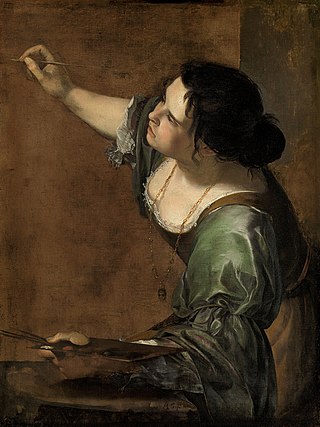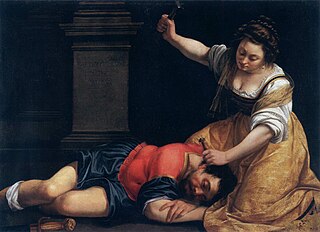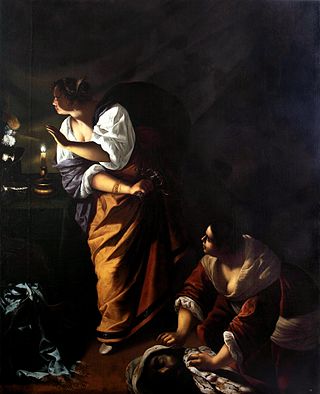
Artemisia Lomi or Artemisia Gentileschi was an Italian Baroque painter. Gentileschi is considered among the most accomplished seventeenth-century artists, initially working in the style of Caravaggio. She was producing professional work by the age of 15. In an era when women had few opportunities to pursue artistic training or work as professional artists, Gentileschi was the first woman to become a member of the Accademia di Arte del Disegno in Florence and she had an international clientele.

The Incredulity of Saint Thomas is a painting of the subject of the same name. It is one of the most famous paintings by the Italian Baroque master Caravaggio, c. 1601-1602. There are two autograph versions of Caravaggio's The Incredulity of Saint Thomas, an ecclesiastical "Trieste" version for Girolamo Mattei which is now in a private collection and a secular "Potsdam" version for Vincenzo Giustiniani that later entered the Royal Collection of Prussia, survived the Second World War unscathed, and can now be admired in the Palais at Sanssouci, Potsdam.
This is an ongoing bibliography of work related to the Italian baroque painter Artemisia Gentileschi.

Self-Portrait as a Lute Player is one of many self-portrait paintings made by the Italian baroque artist Artemisia Gentileschi. It was created between 1615 and 1617 for the Medici family in Florence. Today, it hangs in the Wadsworth Atheneum Museum of Art, Hartford, Connecticut, US. It shows the artist posing as a lute player looking directly at the audience. The painting has symbolism in the headscarf and outfit that portray Gentileschi in a costume that resembles a Romani woman. Self-Portrait as a Lute Player has been interpreted as Gentileschi portraying herself as a knowledgeable musician, a self portrayal as a prostitute, and as a fictive expression of one aspect of her identity.

Judith and Her Maidservant is one of four paintings by the Italian baroque artist Artemisia Gentileschi that depicts the biblical story of Judith and Holofernes. This particular work, executed in about 1623 to 1625, now hangs in the Detroit Institute of Arts. The narrative is taken from the deuterocanonical Book of Judith, in which Judith seduces and then murders the general Holofernes. This precise moment illustrates the maidservant Abra wrapping the severed head in a bag, moments after the murder, while Judith keeps watch. The other three paintings are now shown in the Museo di Capodimonte in Naples, the Palazzo Pitti in Florence, and the Musée de la Castre in Cannes.

Jael and Sisera is a painting by the Italian Baroque artist Artemisia Gentileschi, executed around 1620.

Madonna and Child is an early painting by the baroque painter Artemisia Gentileschi. It was painted around 1613, when Artemisia was around 20 years old. It currently hangs in the Galleria Spada in Rome.

Self-Portrait as a Female Martyr, is also known as the Self-Portrait as a Martyr Saint. This painting was created by the Italian female artist, Artemisia Gentileschi. This self-portrait was made around 1615 depicting the artist herself as a martyr. It is one of two paintings by Gentileschi painted with oil on a wood panel. This self-portrait is currently in a private collection in the United States.

Santa Cecilia is an early painting, from c. 1620, by the Baroque painter Artemisia Gentileschi, a painter described as "a grand exception in the history of art - a successful woman painter in an era in which art was dominated by men."

Judith and Her Maidservant is a painting by the Italian baroque artist Artemisia Gentileschi. Executed sometime between 1645 and 1650, it hangs in the Museo di Capodimonte in Naples. The story comes from the deuterocanonical Book of Judith, in which Judith seduces and then assassinates the general Holofernes, who had besieged Judith's town. The exact moment depicted takes place after the murder when her maidservant places the severed head in a bag, while Judith checks around her.

Susanna and the Elders is a 1652 painting by the Italian artist Artemisia Gentileschi. It currently hangs in the Pinacoteca Nazionale, Bologna. The painting, over two metres broad, was completed in collaboration with Gentileschi's pupil Onofrio Palumbo - documents relating to the sale of the painting mention a payment to Palumbo.

The Self Portrait of Italian baroque artist Artemisia Gentileschi was painted in the early 1630s. It currently hangs in the Palazzo Barberini, Rome. It is one of many paintings where Gentileschi depicts herself. Beyond self-portraits, her allegorical and religious paintings often featured herself in different guises.
Allegory of Inclination is a 1615-1617 oil on canvas painting by Artemisia Gentileschi on the ceiling of the Galleria in the Casa Buonarroti, in Florence. The painting depicts a young nude female seated in the heavens holding a compass. Her light-colored hair is elaborately styled and she is partially covered by swirling drapery. A star appears above her head.

Anna Maria Vaiani was an Italian engraver, who was most known for her botanical engravings and designs.

Portrait of a Lady Holding a Fan is a painting by the Italian artist Artemisia Gentileschi. Executed in the mid-1620s, it is part of the collection of The Sovereign Military Order of Malta. There is no firm idea who the sitter is, although some historians have wondered if the portrait is indeed a self-portrait. However, given the rich clothing and jewellery of the sitter, this is unlikely.

Bathsheba is a 1636-37 painting by the Baroque painter Artemisia Gentileschi, with contributions by Viviano Codazzi and Domenico Gargiulo. It shows the Hittite woman Bathsheba being washed and tended to by her servants. At the top left of the painting, King David sees her from his palace. It was one of seven versions from the story of Bathsheba that Gentileschi painted.

Clio, Muse of History is a painting by the baroque painter Artemisia Gentileschi. It was painted around 1632, just after Artemisia had moved to Naples. It currently hangs in the Palazzo Blu, Pisa. The painting has been interpreted in relationship to Gentileschi's own career and self-image - "by including her signature in Clio's open book, Artemisia was quite literally writing herself into history". In stylistic terms, the painting demonstrates Gentileschi's borrowing from Venetian styles of painting where she "applied her colors in a free and more spontaneous fashion."

Cleopatra is a painting by the Italian baroque artist Artemisia Gentileschi, completed in the mid-1630s. It is owned by a private collection in Rome.

Portrait of a Lady, dressed in a gold embroidered costume is a painting by the Italian baroque painter Artemisia Gentileschi. It is assumed to have been painted in the early 1620s, just after Artemisia had moved to Rome. It currently belongs in a private collection. The identity of the sitter is not confirmed, but strongly believed to be Caterina Savelli, “Principessa di Albano”.

















